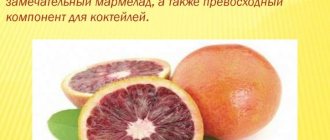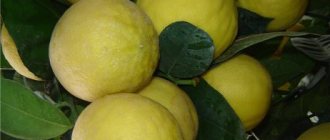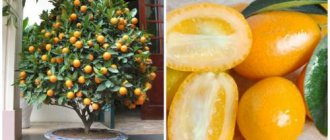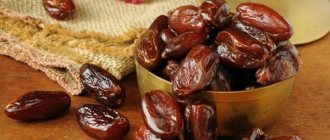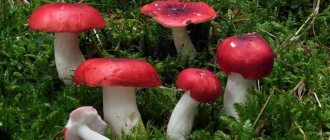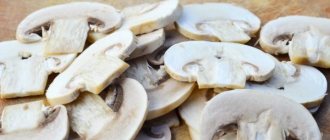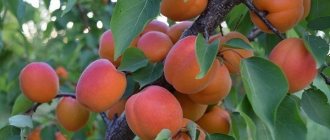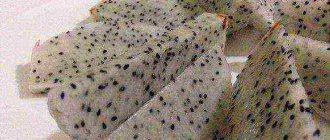Homeland and characteristics of growth
The biological homeland of the plant is considered to be the south and southeast of China. From there the plant emigrated to Asia, then to Japan and the southern parts of the American continent.
Nowadays, Fortunella can no longer be found in the wild. It is grown only in culture.
Origin of name. The most notable part of Fortunella is its small round fruits, colored golden yellow. This plant owes its poetic name to them, translated into Russian meaning “Golden Orange”.
The Chinese call Fortunella Kumquat (Golden Apple), the Japanese call it Kinkwan (Golden Orange).
Due to its miniature size, Fortunella is called "Dwarf Orange"
Benefits of kumquat for the body
It’s not for nothing that the Chinese call kumquat “golden orange”. Thanks to the mineral and vitamin composition, the benefits are felt in any form.
Fresh fruit
The maximum benefit comes from fresh fruits, including peel and juice:
- Crushed fruits with honey treat coughs and sore throats.
- Thanks to the high content of vitamin C, infections are suppressed and the immune system is strengthened. A glass of juice is beneficial during flu epidemics as a preventive measure.
- A couple of fruits will quickly neutralize a hangover.
- Acts as a tonic for the body as a whole. The liver and gallbladder feel particular benefits.
- Vitamin A and beta-carotene prevent the development of cataracts.
- The benefits of fiber include normalizing insulin and glucose levels and inhibiting the development of type 2 diabetes.
- Aging and skin pigmentation are slowed down.
- Pectin, fiber, enzymes regulate the functioning of the gastrointestinal tract. Removes cholesterol, radionuclides, and toxins from the body.
- Helps with nausea, heaviness in the stomach from overeating.
Kumquat is used only fresh for weight loss: the benefits are low in calories plus fiber, which cleanses the gastrointestinal tract.
- Only fresh fruits can be consumed if you have diabetes. The doctor determines the norm.
- If there is no allergy, kumquat is not contraindicated during early pregnancy. You can eat little by little, especially since this neutralizes early toxicosis.
Description
The first mention of this plant dates back to 1646. However, in those distant times it was known to few. A botanical description of the plant was made centuries later, in 1912, by the Algerian scientist Louis Charles Trabu.
Escapes
Fortunella is a low, about a meter, woody plant with branched shoots forming a dense crown. The branches are often smooth, but there are also triangular, slightly flattened branches. In some species they are covered with spines or small green spines. As they grow, the spines become woody and acquire a brown tint.
Leaves
Small: 3–6 cm long and 2–3 cm wide. Simple, lanceolate or oblong, with a pointed apex and venation clearly visible in the light.
Kumquat leaves never change color
Bloom
Fortunella blooms in late spring, covered with small white buds.
Flowers are axillary, solitary or collected in small groups
Fruit
In autumn, the plant produces fragrant, juicy fruits called kumquats.
The structure of Kumquat resembles citrus fruits
The fruit is covered with a glossy golden skin that has a pleasant aroma and sweet-spicy taste. Under the skin there is juicy, sour flesh. In combination with the sweet skin, it gives a sweet, sour taste.
Kumquats are edible. It is a storehouse of vitamins and nutrients. It is eaten in its natural form or processed, producing incredibly tasty candied fruits, marmalades, jams and preserves.
Kumquat in syrup
However, the plant is loved not only for its healthy and tasty fruits.
The tree itself is decorative
Application area
The fruits are consumed fresh, dried or canned. Kumquat is used to make jam, jelly, sweets, candied fruits, marmalade, preserves, juices and infusions. Exotic fortunella is added to ice cream and fruit salads.
Kumquat fruits are used to decorate confectionery products (they are a good addition to desserts), as well as to add flavor to fish dishes. Fruits go well with fresh mint and various spices, incl. with cinnamon, anise, cardamom, ginger, nutmeg. Kumquat is used to make a delicious iced drink.
In cosmetology, the fruits of the citrus plant are used to make facial and hair care products.
Kinds
The genus is not diverse: only 6 species of Golden Apple are cultivated.
Oval kumquat
Also known as Fortunella Margherita and Nagami kumquat.
The most popular species, which is a meter-high tree with smooth, thornless shoots bearing fairly elongated, pointed, dark green leaves.
Fortunella japonica
She is also Marumi kumquat and Round kumquat.
A miniature (up to 50 cm) tree, the shoots of which are covered with thorns. The fruits are small (2–3 cm), lobed (5–7), bright orange. Winter-hardy and very productive species, grown in open ground.
Hong Kong kumquat or "Golden Bean"
Differs in slow growth.
Loved by gardeners as bonsai
When crossing Fortunella with citrus fruits, numerous hybrids were obtained.
Calamondin - a hybrid of mandarin and kumquat
Limequat - a hybrid of lime and kumquat
History of origin and habitat
The citrus tree comes from China and Japan. Fortunella has been cultivated in these countries since the Middle Ages. The plant is sometimes called Chinese mandarin or golden orange.
The culture first appeared on the island of Corfu after the First World War. Thanks to its mild climate, fertile soil and plenty of water, the northern part of the Greek island turned out to be the best place for such an exotic plant.
The crop was imported to Europe by Robert Fortune in 1846. Over the years, many natural and artificial hybrids have appeared.
You should know where kumquat grows:
We recommend that you familiarize yourself with Bergamot Herb
- Large plantations are located on the Pacific coast of South Asia.
- Plants are cultivated in India, Florida, California and the USA.
- Trees are grown in Taiwan, Japan, China, and the Philippines.
100 years ago, botanists tried to grow trees along the Mediterranean coast, but the attempt was unsuccessful (with the exception of the island of Corfu).
Growing
A feature of Fortunella's growing season is its slow growth. The compensation is the longevity of the plant.
Selecting a location
Fortunella loves sunlight and needs long daylight hours.
She will be comfortable on windows of any direction, with the exception of northern ones. In summer, it is better to place the plant outdoors, protecting it from the bright midday sun.
In autumn and winter, lighting and fresh air (regular ventilation) are necessary.
Air requirements
Temperature
Summer optimal temperature is 25–30 °C, in winter no lower than 15–18 °C
Important! The plant does not tolerate temperature fluctuations. When placing it, it is important to exclude even the temperature difference in the room and on the windowsill.
Air humidity
Kumquat needs moist air. This is especially true in winter, when central heating batteries are running. This fact must be taken into account before purchasing a plant.
Contraindications and harm
Like any citrus, kumquat is not universal. It has beneficial properties and contraindications with limitations:
- If you have an individual intolerance to citrus fruits, but really want them, the safe norm is no more than two fruits at a time.
- Tendency to corpulence. Excessive consumption of fruit provokes obesity.
- The acids contained in the fruit make it undesirable for people with gastrointestinal problems (increased acidity of gastric juice, ulcers, gastritis), kidneys, and genitourinary system.
- Prohibited during breastfeeding: it is unknown how the child’s body will perceive it.
- For diabetes, kumquat is consumed only fresh, little by little, keeping an eye on sugar levels. And only after consultation with a doctor.
Even if you are not allergic to regular citruses, two or three slices are enough for the first tasting. There was no discomfort - you can continue to eat kumquats as much as you want.
Care
Rotating
To form a symmetrical crown, the plant is rotated around its axis every 2 weeks. The angle of rotation is easy to calculate: within a year, Fortunella must make a full revolution.
Hydration
The regularity of watering the Golden Apple is determined by the drying of the top layer of soil. In the case of a large plant, it is permissible for the substrate to dry to a depth of 5 cm.
The watering schedule also depends on the season:
- in summer, Golden Orange is watered daily;
- in winter once every 3–4 days;
- every other day in the spring.
Attention! Watering is carried out with warm water that has been standing for 24 hours. To soften hard water, use oxalic acid (a quarter of a teaspoon per 8 liters), after which the water is left to settle for a day.
Top dressing
From the beginning of spring to September inclusive, Fortunella is fed 2–3 times a month, alternating the use of organic matter (wood ash, mullein) and mineral mixtures that do not contain chlorine. In winter, feeding is not stopped, increasing the interval to 1 time per month.
Important! When applying fertilizers, the following rule is followed: the smaller the container in which Kumquat grows, the more often they fertilize.
Transfer
It is held in the spring, in February-March. Its frequency depends on the age of the plant:
- young Fortunellas are replanted whenever it “grows” out of the pot;
- adult fruiting specimens - once every 2–3 years.
In order to preserve the integrity of the roots, transplantation is carried out using the transshipment method. A drainage is placed at the bottom of the pot, on top of which a 4 cm layer of sand is poured, and the substrate is placed on it.
The soil
The plant needs air and permeable nutrient soil.
Examples of its composition:
- 1 hour of fertile greenhouse soil. 2 hours of turf, 1 hour of manure or leaf humus and sand or vermiculite.
- A mixture of equal quantities of turf, coarse river sand or perlite, leaf humus or peat with the addition of ¼ crushed charcoal.
The transplanted plant is placed in a warm place, periodically spraying the crown and watering abundantly for the first 2 weeks.
Calorie content and composition
The benefits of the fruit are due to its saturation with vitamins and minerals. It is considered dietary, but the calorie content of kumquat in sugar is prohibitive.
Calories
Energy value of the product (g/100 g):
- proteins – 1.8-1.9;
- fats – 0.92-1.15;
- carbohydrates – 9.4
Fresh kumquat specimens have a calorie content of 70-75 kcal per 100 grams. Dried or dried “richer” – 270-280. Candied fruits cooked from kumquat have a calorie content four to five times higher - 320-330 units.
Minerals and vitamins
Four-fifths of each fruit is water. The main benefits come from vitamins plus minerals. The vitamin list opens with ascorbic acid - almost half of the total composition. It is supplemented by A, E, group B (3, 5), R. Microelements, minerals:
- potassium;
- calcium;
- sodium;
- magnesium;
- iron;
- zinc;
- copper;
- molybdenum.
The value of the fruit is added by fatty acids (saturated, unsaturated, polyunsaturated), essential oils, monosaccharides, lutein, pectin.
Uniqueness
This is the smallest citrus fruit. It is eaten with the skin - microelements are concentrated in it.
Only kumquat (the only citrus fruit) contains no nitrates. The tree does not absorb them, regardless of the concentration in the soil.
Common varieties
In the countries of Southeast Asia and the southern regions of the United States, only organic types of kumquat are recognized, including:
- Marumi. These are golden-yellow fruits of a round shape, slightly elongated in length. They have juicy and spicy flesh and smooth skin.
- Meiwa. These are large spherical fruits about 4 cm wide. They have aromatic, sweet, seedless pulp and a thick orange-yellow skin.
- Nagami. This is an oval-shaped kumquat, 4.5 cm long. Its flesh is bright yellow and consists of 4-5 segments with seeds. The growing season of the variety is from October to January.
- Hong Kong. This is the original look, also called "Golden Bob". It is represented by tiny fruits with a diameter of no more than 2 cm and not juicy pulp with 2 sections.
Fortunella is used not only in the food industry, but also in interior design. As an ornamental plant with a pleasant citrus aroma, it will harmoniously complement the apartment, giving it comfort and individual style.
Rules for selection and storage
Kumquat is consumed raw and after cooking. When buying fruit, you should pay attention to its appearance, because the shelf life of the product depends on this.
Fresh fruits
When choosing kumquats in the markets of southern countries, it is necessary that they meet certain characteristics, that is, they have:
- smooth and shiny skin without spots;
- medium-hard structure without cracks or damage;
- uniform color (from yellow to orange-red).
You can store fresh fruits at room temperature (no more than 25˚C) for about 7 days or in the refrigerator (from 7˚C) for 21 days.
Dried fruit
Dried fruits must have:
- pale yellow-orange color;
- wrinkled structure without seeds;
- natural taste and color without added sugar or dyes.
Unlike fresh fruits, dried fruits can be stored from 4 months to 1 year. To do this, the product must be placed in a container with a tight lid. Containers with dried kumquats should be placed in a dark and dry place at a temperature of no more than 25˚C.
Kumquat, what kind of fruit? As it is
Kumquat is best eaten whole – unpeeled. This is a fruit that does not tolerate fuss and unnecessary movements. The kumquat has a sweet, thin, edible skin that compensates for the sourness and tartness of the pulp.
If the tartness bothers you, cut one end of the kumquat and squeeze out the juice before eating. Gourmets believe that you need to put the whole fruit in your mouth and chew it to taste the harmony of this smallest citrus fruit. And the longer you chew a kumquat, the sweeter its taste.
You can gently squeeze the fruit with your fingers before eating. This helps release the essential oils from the peel and blend the aromas and some of the flavors.
A word of caution: If you have an allergy to citrus peels, you may need to avoid kumquats.
Kumquat, what kind of fruit is it? Cheesecakes with carrots and spicy citrus sauce with oranges and kumquats from Evgenia Smirnova , see recipe here
How to use in cooking and nutrition
There is a little trick: before cooking, rub the fruit a little between your fingers to release juices and oils that have a sweet citrus taste and dishes with kumquat will be much tastier and more aromatic.
You can add kumquats to salads, both vegetable and fruit. Since it goes very well with almost any food and gives them a pleasant taste.
Like any other citrus fruit, this fruit can be used to make jams, juices, pies and pies.
Because of their original taste, mini oranges are an excellent choice for making cocktails, candies, marmalades and delicious cakes.
Bonus: We encourage you to make this sweet homemade product that will have a special place in your kitchen with your taste.
- Kumquat marmalade
The ingredients you need are: 1 kg kumquat and 0.6 kg sugar.
First, wash the fruit thoroughly and leave it in the water for at least an hour. Then cut each fruit in half and remove the seeds. It is very important to remove them all as they are bitter enough to ruin the taste of the marmalade.
Chop the kumquat fruit into small pieces or put them through a blender to create a smooth mixture. Pour the fruit and sugar into one pan and place over low heat. Stir constantly until you notice that the mass has become thick. Then reduce the heat to low and leave on the stove for another hour.
When the kumquat jam is ready, pour it into glass jars. Cover them well and store in a dark, cool place for at least two days.
Is it possible to have kumquat during pregnancy?
Eating dwarf orange to a pregnant woman will not harm her during the first half of her term, but it is better not to consume this citrus during the last quarter. Since this can cause allergic reactions in the fetus.
Kumquat fruit is recommended for pregnant women due to its high nutritional content. They strengthen the immune system and help fight recurring infections that occur as a result of the bactericidal and antifungal properties of kumquat.
In addition, kumquat improves digestion, so it can be useful for flatulence and stomach upsets during pregnancy. Eating kumquat helps in cleansing the body of toxins.
Consumption of kumquat during pregnancy has virtually no contraindications. However, citrus fruits can still cause allergic reactions, so if you notice any symptoms, stop eating dwarf orange.
